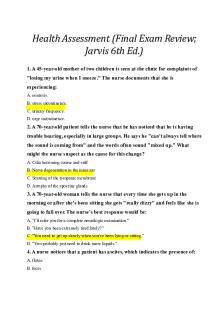Chapter 004ONNotes - Jarvis PDF

| Title | Chapter 004ONNotes - Jarvis |
|---|---|
| Author | michael waite |
| Course | Microbiology |
| Institution | New York University |
| Pages | 2 |
| File Size | 70.1 KB |
| File Type | |
| Total Downloads | 18 |
| Total Views | 152 |
Summary
Jarvis...
Description
Jarvis: Physical Examination and Health Assessment, 8th Edition Chapter 04: The Complete Health History Answer Keys: Study Guide and Lab Manual 1. The purpose of the complete health history is to collect subjective data (what the person says about himself or herself). The history is combined with the objective data that are obtained from the physical examination and laboratory studies to form the database. The database is used to make a judgment, or diagnosis, about the health status of a person. 2. Critical characteristics used to explore symptoms: (1) Location. (2) Character or quality. (3) Quantity or severity. (4) Timing. (5) Setting. (6) Aggravating or relieving factors. (7) Associated factors. (8) Patient’s perception. 3. Elements include the following: Reason for seeking care: a brief, spontaneous statement, in the person’s own words, which describes the reason for the visit. Present health or history of present illness: for the well person, a short statement about the general state of health. For the ill person, a chronologic record of the reason for seeking care, from the time the problem started until the present. Past health: previous health events and previous experiences with illness. Includes childhood illnesses, accidents or injuries, serious or chronic illnesses, hospitalizations, operations, obstetric history, immunizations, last examination date, allergies, and current medications. Family history: age, health, or the age and cause of death of blood relatives, such as siblings, parents, grandparents. Review of systems: an orderly assessment of symptoms r/t each body system. The order of the examination of body systems is generally done in head-to-toe fashion, and health promotion practices are assessed. Functional assessment: measures a person’s self-care ability in the areas of general physical health or absence of illness. Includes activities of daily living (ADLs) such as bathing, dressing, toileting, eating, walking, and instrumental activities of daily living (IADLs) such as housekeeping, shopping, doing laundry, using the telephone, and managing finances. 4. Family history data may have genetic significance for the patient. In addition, the person’s prolonged contact with a family member with any communicable disease, or the effect of a family member’s illness, should be assessed. 5. Define a pedigree or genogram: A pedigree or genogram is a graphic family tree that uses symbols to depict the gender, relationship, and age of immediate blood relatives in at least three generations, such as parents, grandparents, and siblings (see Fig. 4.4).
Copyright © 2020 by Elsevier Inc. All rights reserved.
Answer Keys: Study Guide and Lab Manual
4-2
6. Review of systems: Evaluation of past and present health state of each body system, ensuring that no significant data were omitted in the present illness section and evaluating health promotion practices. 7. The functional assessment includes the following items: Self-esteem, self-concept Activity/exercise Sleep/rest Nutrition/elimination Interpersonal relationships/resources Spiritual resources Coping and stress management Personal habits Alcohol Street drugs Environment/hazards Intimate partner violence Occupational health
Copyright © 2020 by Elsevier Inc. All rights reserved....
Similar Free PDFs

Chapter 004ONNotes - Jarvis
- 2 Pages

Chapter 001ONNotes - Jarvis
- 2 Pages

Chapter 04 Jarvis summary
- 2 Pages

Chapter 016 - Jarvis
- 3 Pages

JARVIS SYNOPSIS
- 5 Pages

Jarvis Final Exam Review
- 12 Pages

Jarvis (Project Report)
- 20 Pages

349170776 Ch09 Jarvis Test Bank
- 17 Pages
Popular Institutions
- Tinajero National High School - Annex
- Politeknik Caltex Riau
- Yokohama City University
- SGT University
- University of Al-Qadisiyah
- Divine Word College of Vigan
- Techniek College Rotterdam
- Universidade de Santiago
- Universiti Teknologi MARA Cawangan Johor Kampus Pasir Gudang
- Poltekkes Kemenkes Yogyakarta
- Baguio City National High School
- Colegio san marcos
- preparatoria uno
- Centro de Bachillerato Tecnológico Industrial y de Servicios No. 107
- Dalian Maritime University
- Quang Trung Secondary School
- Colegio Tecnológico en Informática
- Corporación Regional de Educación Superior
- Grupo CEDVA
- Dar Al Uloom University
- Centro de Estudios Preuniversitarios de la Universidad Nacional de Ingeniería
- 上智大学
- Aakash International School, Nuna Majara
- San Felipe Neri Catholic School
- Kang Chiao International School - New Taipei City
- Misamis Occidental National High School
- Institución Educativa Escuela Normal Juan Ladrilleros
- Kolehiyo ng Pantukan
- Batanes State College
- Instituto Continental
- Sekolah Menengah Kejuruan Kesehatan Kaltara (Tarakan)
- Colegio de La Inmaculada Concepcion - Cebu







